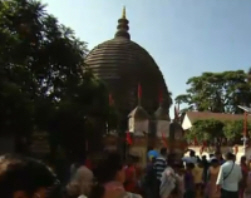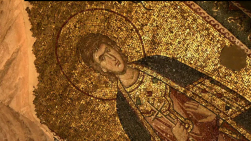St. Peter’s Basilica
Buried Treasures
There is physical evidence of that victory. Just up here is St Peter’s Basilica it’s one of the most influential and totemic of all of Christianity’s
power bases. But this complex was not built on virgin soil. Hundreds of years before St Peter’s was built, Kybele’s worshippers came here in their droves.
Priests made bloody sacrifices to the Great Mother. This is where they slaughtered bulls in her honour. Drenching themselves in animals’ blood.
St. Peter’s Basilica
In 1609, the Vatican archivist called Giacomo Grimaldi made very detailed notes of some reconstruction work that was going on here. And what’s
fascinating, if you read them, is that you find out that underneath this entire Basilica complex there are vast numbers of remains of the sanctuary
of the Great Mother.
About 30 spans deep into the ground, the remains of the Pagan altars were discovered, some of which were smashed into pieces with iron bars by
Christians, dumped unburied in contempt for this idolatry, one thrown on top of the other.
Christians wouldn’t allow the Great Mother to survive in the new order. Her cult was obliterated. She was symbolically and physically buried.
Worshipping one God left no space for goddesses. But in societies that honour many gods, goddess worship has proven incredibly durable.
I’m heading East to pick up the goddess trail. Nearly 900,000,000 people follow Hinduism, making it the third largest religion in the world and the most
popular polytheistic faith of the modern age. I’ve pieced together the clues from prehistory and the ancient world to try to recover those goddesses that
were buried long ago. But here in India, they are alive and well.
While Christianity was suppressing goddess worship, in Central Asia, right the way across to Afghanistan and here in the Indian subcontinent, it
was gathering strength.
Durga
One object of devotion was the goddess Durga. She sits right at the heart of Hinduism one of the most ancient living religions. Hinduism emerged more
than 3,500 years ago. Its central beliefs were written down in an ancient language called Sanskrit, in sacred texts known as the Vedas. These record
many of the gods and goddesses of the Hindu pantheon.
Whenever I’ve been, whether it’s been Greece or Turkey or Rome, I’ve found this kind of a jigsaw puzzle of evidence that people believe that the
central sacred power was feminine. And what’s really intriguing about coming here is that I’ve discovered that that idea has been physically set
in stone.
There is a temple that I’m going to now where hundreds of thousands of worshippers still come every year. This is, the Kamakhya Temple, high in the
hills of Assam, one of the most sacred goddess temples in India. It’s dedicated to her yoni, Sanskrit for womb or vagina, which, it is believed, fell
here from heaven.

Kamakhya Temple
For nine days every year, hundreds of thousands of Hindus come to warship Durga and to celebrate a great festival in her honour, the Durga Puja.
The festival celebrates the birth of the goddess Durga and her epic battle with the evil Demon King. This famous story was first recorded in the fifth
or sixth centuries AD, in one of the most important religious texts in Hinduism, called the Devi Mahatmyam. According to be sacred text, the Demon King
takes the form of a buffalo and terrorises the heavens and Earth.
And yet these eunuch priests wore women’s clothes, they used to put their long hair up an elaborate styles and wear very garish make-up. There are even
rumours that some of them worked as temple prostitutes and indulged in orgiastic sex frenzies. It’s little surprise that, originally, Roman citizens were
banned from being priests of the Great Mother.
I’m fascinated by these eunuch priests and why did emasculate themselves for a goddess. Professor Corey Brennan is from the American Academy in Rome.
Brennan: “The Galli were what I’d call a negative foil to the goddess. In other words, you have this very, very powerful woman and her powers are
even magnified by being surrounded by effeminate men with high voices, wearing feminine dress, make-up and who had been castrated.”
How does self-castration become a religious act?
Brennan: “I think the Galli work themselves into a state of ecstasy and this allowed them all so to do the self-mutilation and some of the more
outrageous forms of worship that went along with the cult. One thing that runs through this is sort of initiates’ remorse after having been initiated
and come out of this frenzied ecstatic state and say, ‘what have I done?’ Because you really are painted into a corner. You are, de facto, in the
service of this goddess for the rest of your life.”
I’m really curious to understand what the war-mongering Romans made of these emasculated priests.
Brennan: “The self-castrated priests were so foreign to the Romans that they decreed that only foreigners could serve in the cult. The Romans were
banned this didn’t mean that it didn’t have a certain attraction for Romans. Every once in a while, we can actually detect Romans sneaking into the
cult and, in fact, going the full measure, including self-castration in service of the goddess.”
Magna Mater’s subversive cult went from strength to strength in Roman society. Within 100 years even Roman citizens were allowed to become her
priests. And, at another critical moment in our history, Rome returned to the goddess once more. In the first century BC, Rome was plunged into
the horrors of civil war. Men vied for control of what would become the world’s greatest empire. In 44 BC, Julius Caesar, the famous general and
statesman, was assassinated. His adopted heir emerged triumphant as Augustus, Rome’s first Emperor. To cement his control, he called on the
Magna Mater. I’m meeting historian Alexander Evers to find out why.
Alexander Evers
Alexander Evers “The Republic has come to an end and Augustus is the heir apparent, who begins to build an empire from scratch almost and he really
needs all the forces on board. He makes Magna Mater one of the central figures. She’s the big mamma, she will protect you. She’s there, not just with
Augustus, but she’s also there for the Romans.”
But why did he choose? Because he’s got lots of very powerful male gods, very warlike gods, and yet he goes for the goddess.
Alexander Evers “On the one side, she’s powerful, and aggressive, violent, scary. On the other hand, she’s the Great Mother and she will look
after you, she will protect you, she will nurse you who and so, these two elements make the perfect fit, in a way.”
Although she was now part of the official, state religion, this wild goddess was not tamed. Across the Empire, live bulls were sacrificed in their
thousands to satisfy her bloodlust. For four centuries the Great Mother’s blood rites and how eunuch priests flourished here in the capital.
Emperor Augustus
And then, in the early centuries of the first millennium, a new religion would emerge from the East that would challenge the Goddess’s control of the Empire.
Christians fervently believed there was just one God. It’s followers were hostile to the goddess and her ritual sacrifices. Their new faith spread and
grew in strength and, by the end of the fourth century, it was the official religion of the Roman Empire. Pagan worship was banned. The goddess was now
an outlaw. Christianity had triumphed.
Neither man nor God can defeat him, so the gods combine their celestial power to create Durga – the Shining One. She appears riding a lion and carrying a
fearsome weapon in each of her many arms.
After a titanic series of battles, Durga slays the buffalo Demon, liberating humanity and the gods. Almost 1500 years later, Durga’s worshippers
re-enact her great victory by sacrificing buffalos in her honour. The animal’s being prepared for sacrifice by the priest who is covering it in
garlands and flowers and herbs. And, actually, the blade that’s going to be used is being prepared too. This bloody celebration is inspired by
the story told in the Devi Mahatmyam.

